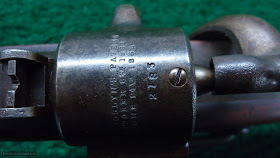The story of the Joslyn Firearms Company will have to start with the man who started the company, one Benjamin Franklin Joslyn. Josyln was born in 1821 in Worcester, Massachusetts.
Probably influenced by living in "gun valley", he became interested in firearms and at the age of 34 he designed and patented a breech loading carbine.
This was the mid 1800s, breech loaded weapons were a new advance at the time and the metallic cartridge was not quite ready for prime time, so his carbine used a paper cartridge, ignited with a percussion cap.
Not having the means to produce the weapon he contracted with Asa H. Waters in nearby Millbury, MA.
Waters was a gunsmith and his families armories had been producing weapons in MA since the mid 1600s, see the story of the Waters Armory here.
The gun had a long breech block that folded into the tang of the stock and held in place with a ring in which the shooter inserted his thumb. This odd look gave the carbine its nickname of the "Monkey Tail Carbine". It was officially named the Joslyn Carbine Model of 1855.
As you might expect the civilian market for firearms was not that large in 1855, especially for an unconventional weapon. So Joslyn sought to sell his carbine to the U.S. Army.
Through a connection he had at Colt (a relative of some sort) and his hiring of William Freeman, a promoter of firearms, he was able to get his carbine included in the Army's Field Tests in 1857 and 1858. His Carbine came in second place to the Burnside Carbine in both tests. Nonetheless, the Army did purchase 1,200 carbines for further testing. This represented the bulk of the 1,500 or so carbines that were built at Waters Armory. The remaining 200 or so probably went to the U.S. Navy who ordered 500 of the 1855 Carbines, yet records indicate only 200 or so were delivered. This may have been because Joslyn had yet to procure his own factory.
Joslyn had also designed a 44 Caliber revolver and in 1858 contracted with William Freeman to have the revolver built. Joslyn was able to secure a contract with the U.S. Navy for 500 of the revolvers, but the contract was cancelled when Freeman was unable to deliver them.
Joslyn was learning that he needed to be in control of his own manufacturing.
Joslyn cured that problem around the time the Civil War broke out. He leased a factory on the harbor in Stonington, MA. The factory had previously been used to produce horseshoe nails.
Joslyn produced somewhere between 2500 and 3000 of his revolvers, about 1100 of which were purchased by the Union Army for the war.
It was also around this time that the rimfire metallic cartridge was gaining popularity and Joslyn was ready with a new design to accept them.
In October of 1861 he patented his new rifle, it was dubbed the model of 1862. Rather than a long monkey tail breech, it used a block that rolled to the side to expose the breech.
Joslyn refined the model of 1862, mainly fixing the breech latch, which was held in by friction and a ball/detent. He added a locking lug, operated by a pull knob to open the breech and changed the chambering to .56-52 Spencer. The new carbine was named the model of 1864
The 1864 model gained favor with the Union Army, some 8,000 were provided to the troops. In addition the Springfield Armory purchased a lot of 3000 or so breech assemblies in order to produce their own rifles. These were the first breech loading rifles made at Springfield.
By 1868 Joslyn had to fold up shop and the assets were sold at auction.
In 1871 6,600 carbine and 1600 rifles were rechambered in .50-70 Government and sold to France for use in the Franco-Prussian War. Many of the guns that survived the war, were converted to shotguns and sent to Africa for use in European Campaigns in the dark continent.
What remains.
The Waters Armory on the Blackstone River in Millbury disappeared long ago, in its place is the local VFW hall.
After the demise of the Joslyn Firearms Co. the Stonington factory was leased to the Atwood Machine Company, which made tooling to produce silk thread. After Atwood closed in 1945, Emhart Machine moved in, then they were replaced by The Plax Corporation and finally the Monsanto Corporation, who vacated the building in 1982.
On July 3rd, 2003 the building(s) caught fire, presumably from fireworks.
Only the shell remained.....
Like many old gun factories, the buildings and land were rebuilt and turned into a mixed use complex including office space and condos, it is now called Stonington Commons.
Sources:
American Society of Firearms Collectors
http://mail.stoningtonhistory.org/index.php?id=54
https://connecticutmills.org/find/details/atwood-machine-co
https://www.militaryfactory.com/smallarms/detail.asp?smallarms_id=1163















No comments:
Post a Comment